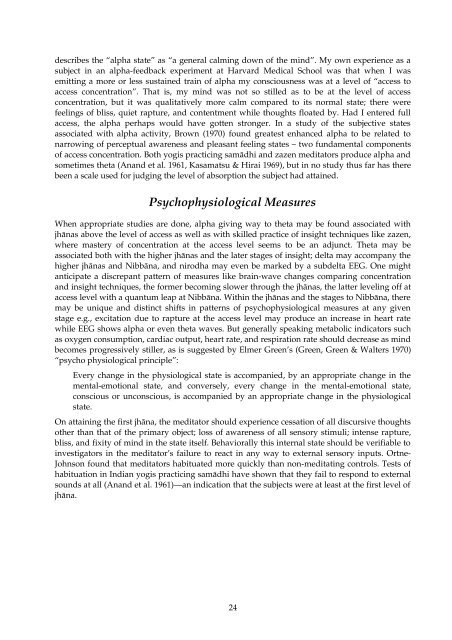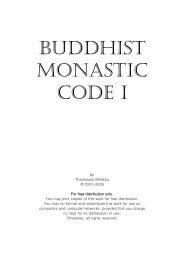THE BUDDHA W MEDITATION - Theravada Buddhism
THE BUDDHA W MEDITATION - Theravada Buddhism
THE BUDDHA W MEDITATION - Theravada Buddhism
Create successful ePaper yourself
Turn your PDF publications into a flip-book with our unique Google optimized e-Paper software.
describes the “alpha state” as “a general calming down of the mind”. My own experience as a<br />
subject in an alpha-feedback experiment at Harvard Medical School was that when I was<br />
emitting a more or less sustained train of alpha my consciousness was at a level of “access to<br />
access concentration”. That is, my mind was not so stilled as to be at the level of access<br />
concentration, but it was qualitatively more calm compared to its normal state; there were<br />
feelings of bliss, quiet rapture, and contentment while thoughts floated by. Had I entered full<br />
access, the alpha perhaps would have gotten stronger. In a study of the subjective states<br />
associated with alpha activity, Brown (1970) found greatest enhanced alpha to be related to<br />
narrowing of perceptual awareness and pleasant feeling states – two fundamental components<br />
of access concentration. Both yogis practicing samādhi and zazen meditators produce alpha and<br />
sometimes theta (Anand et al. 1961, Kasamatsu & Hirai 1969), but in no study thus far has there<br />
been a scale used for judging the level of absorption the subject had attained.<br />
Psychophysiological Measures<br />
When appropriate studies are done, alpha giving way to theta may be found associated with<br />
jhānas above the level of access as well as with skilled practice of insight techniques like zazen,<br />
where mastery of concentration at the access level seems to be an adjunct. Theta may be<br />
associated both with the higher jhānas and the later stages of insight; delta may accompany the<br />
higher jhānas and Nibbāna, and nirodha may even be marked by a subdelta EEG. One might<br />
anticipate a discrepant pattern of measures like brain-wave changes comparing concentration<br />
and insight techniques, the former becoming slower through the jhānas, the latter leveling off at<br />
access level with a quantum leap at Nibbāna. Within the jhānas and the stages to Nibbāna, there<br />
may be unique and distinct shifts in patterns of psychophysiological measures at any given<br />
stage e.g., excitation due to rapture at the access level may produce an increase in heart rate<br />
while EEG shows alpha or even theta waves. But generally speaking metabolic indicators such<br />
as oxygen consumption, cardiac output, heart rate, and respiration rate should decrease as mind<br />
becomes progressively stiller, as is suggested by Elmer Green’s (Green, Green & Walters 1970)<br />
“psycho physiological principle”:<br />
Every change in the physiological state is accompanied, by an appropriate change in the<br />
mental-emotional state, and conversely, every change in the mental-emotional state,<br />
conscious or unconscious, is accompanied by an appropriate change in the physiological<br />
state.<br />
On attaining the first jhāna, the meditator should experience cessation of all discursive thoughts<br />
other than that of the primary object; loss of awareness of all sensory stimuli; intense rapture,<br />
bliss, and fixity of mind in the state itself. Behaviorally this internal state should be verifiable to<br />
investigators in the meditator’s failure to react in any way to external sensory inputs. Ortne-<br />
Johnson found that meditators habituated more quickly than non-meditating controls. Tests of<br />
habituation in Indian yogis practicing samādhi have shown that they fail to respond to external<br />
sounds at all (Anand et al. 1961)—an indication that the subjects were at least at the first level of<br />
jhāna.<br />
24






